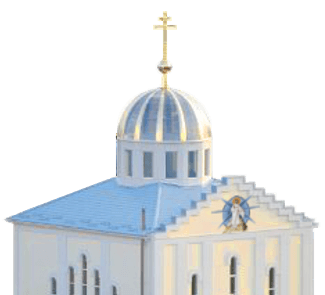![]()
S t. Nicholas the WonderworkerSaint Nicholas is the most revered saint in the Rus'-Ukraine since ancient times - he was born in Asia Minor in the second half of the III century (in about 270) in the Greek colony of Patara in Lycia in the Roman province in a family of wealthy Christian parents, in his youth he was given to the service of God under the guidance of his uncle, the bishop of Patara. His uncle brought him to the priesthood. The whole life of the saint really was a model of Christian service to God and others. When his parents died, St. Nicholas inherited their fortune, which he gave to charity. Saint Nicholas was a bishop of Myra, a city of Lycia, in Asia Minor (modern Demre), his ascetic life and miracles won fame during his lifetime.
Saint Nicholas the Wonderworker, Archbishop of Myra in Lycia (Byzantium), has the most developed iconography. The oldest and the most common type of holy icons are his bust-length portraitures with Deesis and some other saints in the margins. They were created in the Byzantine Empire and in the Rus in the eleventh - thirteenth centuries. Traditionally, in his bust-length icon St. Nicholas does a stavros blessing with his slightly raised right hand, and in his left hand he carries a closed Gospel, in the top in the Heaven there are bust-length figures of the Christ and the Virgin Mary.
The characteristic arrangement of the fingers, called stavros blessing, gets a wide spread occurrence because of the reforms of Patriarch Nikon, the active defender of the "right" arrangement of the three fingers, instead of the "wrong" two-finger crossing. Stavros blessing can be used only by a bishop or a priest to bless. Each finger represents a letter of the Greek alphabet, which is the monogram of the name of Jesus Christ - IC XC (the index finger is extended, which is the letter I, the long finger is slightly bent and looks like the letter C, the thumb is crossed with the ring finger and makes X, the little finger is raised and is similar to the letter C. IC XC - Jesus Christ).
In many icons in the surrounding of St. Nicholas (in the clouds or medallions) there are images of the Christ and the Virgin Mary, returning the Gospel and omophorion to St. Nicholas - the attributes of the episcopal dignity. It is the reminder of the miracle of the Council of Nicene in 325 AD. The question was raised about the doctrine of Arius, who had claimed that Jesus Christ had had only a divine nature, but hadn’t had a human one. This doctrine was defined as heretical, false. During the debate Saint Nicholas hit Arius in the face. The priests, gathered at the Council, decided that such acts of jealousy were unacceptable and by their general solution Nicholas was deprived of episcopal dignity and put in prison. However, many of them had a vision in a dream, in which the Lord gave him the Gospel, and the Holy Mother of God wore the omophorion on him. After this, the episcopal dignity was returned to the saint.
The traditional images of St. Nicholas are those with a closed Gospel in his hand, the less common are icons with an open Gospel, even though such images are from the XIII century. On the pages of the book there is the beginning of the service text to St. Nicholas. The especial distribution of this iconography occurs in XVIII-XIX centuries. Exactly in such a way St. Nicholas is presented on the Old Believers' icon of the XIX century - with the accentuated two-finger crossing and an open Gospel in the hands of the saint.
On many icons around St. Nicholas on the top and side margins there are certain saints or the saint’s hagiographical border scenes.
The great saint Nicholas did a lot of the great wonders during his life and after the death. One of the legends describes the miracle that took place in Kiev in the XI century. Once a couple was in a hurry to Vyzhgorod on the day of memory of Saints Boris and Gleb. When they returned, their baby inadvertently fell into the Dnieper River and drowned. The parents offered prayers to the eternal assistant Saint Nicholas. In the morning in Kiev’s Saint Sophia Cathedral the baby was found alive in wet clothes. He was lying in front of the icon of St. Nicholas.
To this day, St. Nicholas helps the calling for his intercession before the God. People pray the saint for healing, for help in various ills, for good family relationships, for well-being in the way, for children, for protection of widows and orphans, for a problem-free voyage, for help in poverty and need, from sadness and discouragement. Being alive Saint Nicholas became famous as a defender of the innocent prisoners, a pacifier of the feuding and a deliverer of death in vain. He helps everyone: ordinary people and scholars, believers and non-believers, even many Muslims and Buddhists refer to him. The cause of universal access to Saint Nicholas the Wonderworker is almost instant help from the God through the prayers of this great saint.
The saint Nicholas died in about 345 and was buried in the city of Myra in Lycia. In 1087, when the Turks took the city, his relics were translated to the Italian city of Bari. Local veneration of the saint began immediately after his death. In Constantinople in IV-VII centuries. To the Rus the veneration of Saint Nicholas comes with the adoption of Christianity, and from the XI century it becomes widespread.
Commemoration of Saint Nicholas is on 6/19 December, 29 June/11 August (the nativity of the saint), 9/22 May (translation of the relics).

